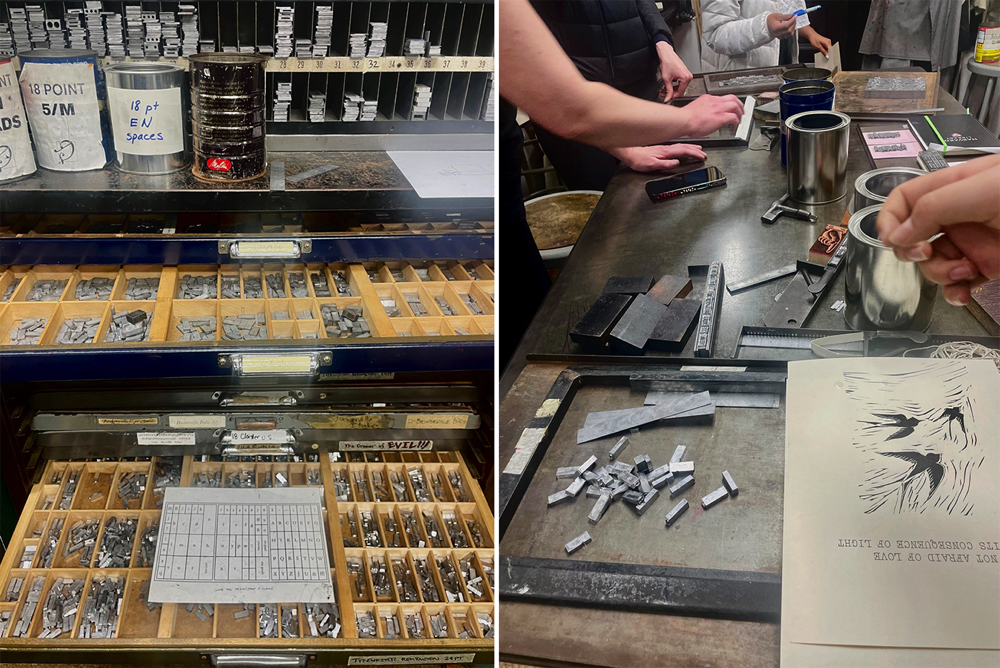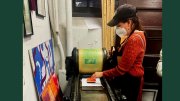Since 1978, in a quiet corner of Adams House, a small studio founded by students has made available vintage printing presses and type for anyone wishing to learn the venerable art of letterpress printing. Its location at the intersection of Bow and Arrow Streets lent a natural name: the Bow & Arrow Press. Now the Press’s location and future are in question, after the Adams House community was informed on Sunday that it will no longer be in Adams House at the corner of Bow and Arrow streets.
Letterpress’s roots lie in the invention of ceramic moveable type by Bi Sheng (990-1051) during the Northern Song dynasty in China. Johannes Gutenberg introduced it to the West in about 1440. For centuries, letterpress was the primary method of printing on paper, using movable type and ink to print newspapers, magazines, broadsides, posters, and books, among other things that rollers might press against the inked designs or words on plates. In the later 20thCentury, offset printing displaced letterpress in most commercial applications, but it remains alive and admired today as an artisanal medium.
For 45 years, Bow & Arrow Press has taught letterpress to all comers in the Harvard community—students, faculty, staff, alumni—largely free of charge. In one-day “crash courses,“ or weekend workshops, and even academic classes for degree credit, anyone interested could explore letterpress in a “maker space” featuring hands-on engagement in a collaborative venue that sidelines Harvard’s highly competitive atmosphere.
Thousands have discovered the joys of letterpress there, sometimes with life-changing results. For example, Matthew Butterick ’92, author of the award-winning Typography for Lawyers, found a love for typefaces at the Press and remains a typographer and designer today. Sasha Wizansky ’95 became a book and graphic designer who also works as a publishing consultant. One of the first students to print at Bow & Arrow was theater director Peter Sellars ’80, who ran off posters for his Harvard stage productions. Later, playwright David Mamet did the same. Poet Seamus Heaney, Litt. D. ’98, became a Bow & Arrow familiar during his Harvard years. Recently, novice printer Daniel Foster ‘23 came to the Press with an idea, posted a proof on Instagram, and soon got a commission from Harvard’s Dumbarton Oaks Research Library and Collection in Washington, D.C., for a new letterpress piece.
The COVID pandemic closed down the tiny studio for a couple of years. But when Bow & Arrow reopened this year, eager learners again swarmed in for courses and for the weekly Wednesday evening “open press nights.” At these, the welcome mat is out for anyone to pursue personal printing projects on the antique presses. Typically, from 25 to 35 show up, and get help from fellow printers and the two non-resident Adams House tutors, Heather Hughes and Jonathan Biderman, who have overseen Bow & Arrow’s activities in recent years.

Left: printers’ type cases. Right: an “open press night” on Wednesday, April 19, drew a large crowd.
Photographs by Craig Lambert
The popularity of the studio, thriving amid the current revival of letterpress as an art medium, led its denizens (there are no “members”—the studio welcomes the Harvard community at large) to anticipate a bright future following the current Adams House renewal project. Several years in the making, the renewal kicked off in 2019 with work on Claverly Hall. The architects’ plans consistently included the Press, and at a virtual “town hall” meeting on February 1, 2023, senior project managers presented a floor plan showing the Press intact in its historic basement corner of Adams House’s Westmorly Court building.
During the last several years of Adams renewal planning, “Press people remained actively involved in the process,” says Hughes. “All the designs have included the little corner where we exist. We were always taken into account. We were even asked for a wish list—what did we want the space to look like?”
Renewal plans included increased accessibility and improved ventilation. In November 2022, Hughes and Biderman took part in a meeting of about a dozen stakeholders, including Adams House Faculty Deans Mercedes Becerra and Salmaan Keshavjee, House administrators, renewal planners, a project manager, and a representative of the architects. “We saw blueprints for Bow & Arrow and we all got on the same page,” Biderman recalls. “Or at least, we thought so.”
It came as a shock to Hughes and Biderman to learn that the Bow & Arrow Press would not be invited back to Adams House when it re-opens in 2025 after renovations. Faculty Deans Becerra and Keshavjee announced this in an email to the Adams House community on April 16. “For the last 45 years, since the Press was moved into Adams House, students in Westmorly Court have not had a common space where they can congregate,” it read in part, and later explained that in 2025, “the space where the Press is located will revert to its original usage as a common room—not unlike the Lower Common Room—for student use and as a gathering place for the Adams House community. With its location next to the Pool Theater, it will also serve the campus theater community as an overflow space for the Arts, something integral to the history of Adams House.”
Becerra and Keshavjee went on to say that “our hope is for its [Bow & Arrow’s] operations to continue at another site in the Harvard community. We are working with the Dean of the College, and through his office, various campus partners to secure a new home for the Press.”
Harvard College released this official statement on the matter: “A critical component of House Renewal is aligning updates with current student needs. The space now dedicated to the Bow & Arrow Press will return to serving as a shared student common space. The Bow & Arrow Press has been an important part of our community for many years. We look forward to this tradition of printmaking continuing at Harvard, and are currently looking for a new suitable location.”
Thus the eviction of Bow & Arrow from Adams House does not necessarily foretell the end of the Press. Finding another appropriate site on campus isn’t impossible, but the unique needs of century-old letterpress equipment, for example, make it a rather daunting task. And after 45 years there, a warm connection with Adams House undergraduates has been a core element in Bow & Arrow’s history. “Our focus is on making sure that the students of Adams House and the users of the Press have a say in what happens next,” Biderman says. “Staying here was always part of the renewal plan until this eleventh-hour reversal. Deciding to eliminate or relocate Bow & Arrow without input from these stakeholders is a disservice to 45 years of this being a student-founded and educational press.”
“It’s always been self-powered,” says James Barondess ’79, Ph.D. ’93, one of Bow & Arrow’s founders. “We were never part of a department. It’s always been our quirky little thing. We never had a lot of friends in high places.” He adds that before the Press moved in, the venue was not a common space for students. Regarding “common space,” Julia Pastreich ’25 expresses a view prevalent among current Adams House students, asking, “What do we need another common room for? We don’t even use the ones we already have!’”
“Arts and crafts spaces have had a rough go under House renewal,” Hughes adds. “Eliot House is up next and they are very concerned about keeping their woodworking studio. My understanding is that Harvard wants to do more to encourage art-making by undergraduates. So it’s counterintuitive to remove arts spaces.”
Another thing that a new location would find hard to match is the abundant foot traffic on Bow Street, which often draws in new printers. “When people walk by and hear the press running, they are captivated,” Biderman explains. “A door or window is open, and they wonder, what is this place? They are really curious and get enthralled. It’s pretty magical!”








